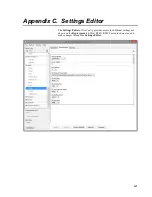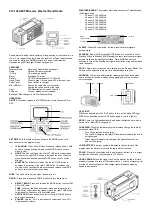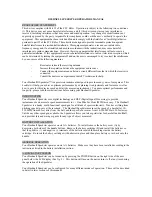
Appendix D. Distance vs. Antenna Gain, Terrain, and Other Factors
D-4
TABLE D-2. Cable Loss
Cable Type
Outside Diameter Loss (dB/100 ft) @ 900 MHz
RG-58A/U
0.195 in
21.1
COAX RPSMA-L
0.195 in
11.1
RG-8
0.405 in
6.9
COAX NTN-L
0.405 in
4.5
LMR-400
0.405 in
3.9
*CSI stocked antenna cables are shaded.
Campbell Scientific’s COAX RPSMA-L uses LMR-195 antenna cable. Cable
loss is proportional to length as the following table illustrates.
TABLE D-3. LMR-195 Cable Loss vs. Length @ 900 MHz
Length (ft)
Loss (dB)
100
11.1
50
5.6
25
2.8
10
1.1
6
0.7
D.2.5 Antenna Gain
Increasing antenna gains improves signal strength and, potentially, distance.
For example, in the context of free space path loss and all other factors being
equal, an increase of 6dB in antenna gain theoretically extends the attainable
distance by a factor of 2. An antenna’s gain is a function of directivity. For
highly directive antennas such as the Yagi, the narrower beam width makes
antenna alignment and orientation more critical.
Antenna gain is specified either in dBi (decibels of gain relative to an isotropic
radiator) or in dBd (decibels of gain relative to a dipole). The relationship is:
dBi = dBd + 2.15
Some antennas that are FCC approved for use with the RF451 series are:
TABLE D-4. Antenna Gain of Recommended Antennas
Mfg.
Antenna Type
Band
Model
CSI Part
Number
dBd
Gain
dBi
Gain
Size
Astron
Omni (1/2 wave) 900 MHz
AXH900 RP SMA R
14204
0
2.15
6.75 in
Antenex
Collinear
900 MHz
FG9023
14221
3
5.15
24 in
Larsen
Yagi
900 MHz
YA6900W
14205
6
8.15
17.5 in
Summary of Contents for RF451
Page 2: ......
Page 6: ......
Page 10: ...Table of Contents iv ...
Page 34: ...RF451 Spread Spectrum Radio 24 ...
Page 36: ......
Page 46: ...Appendix B Installation Scenarios B 10 ...
Page 58: ...Appendix D Distance vs Antenna Gain Terrain and Other Factors D 10 ...
Page 60: ......
Page 61: ......











































